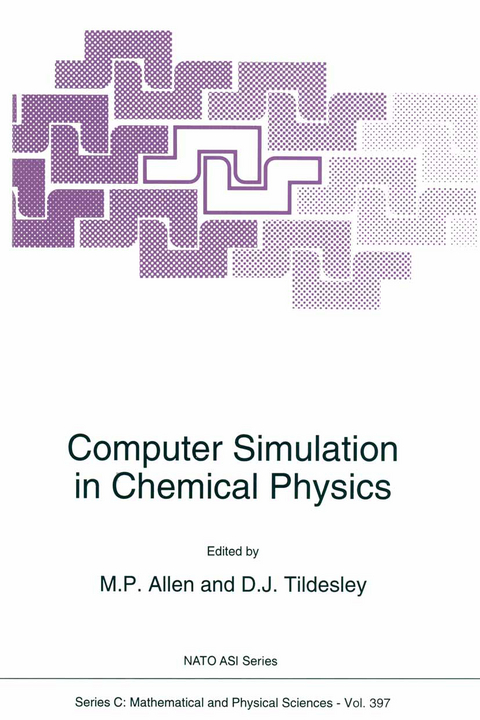
Computer Simulation in Chemical Physics
Springer (Verlag)
9789401047340 (ISBN)
All these exciting developments, an more, are discussed in an accessible way here, making the book indispensable reading for graduate students and research scientists in both academic and industrial settings.
1 The Monte Carlo Method.- 1.1 The Metropolis algorithm.- 1.2 Other ensembles.- 1.3 A non-symmetrical underlying matrix.- 1.4 Molecular systems.- 1.5 Polymers.- 1.6 Conclusions.- 2 The Molecular Dynamics Method.- 2.1 Introduction.- 2.2 Constraint dynamics.- 2.3 Long-range forces.- 2.4 Conclusions.- 3 Back to basics.- 3.1 Introduction.- 3.2 Average values, fluctuations and errors.- 3.3 Ensembles and distributions.- 3.4 Distribution functions.- 3.5 Finite-size scaling and phase transitions.- 3.6 Transport coefficients.- 3.7 Conclusions.- 4 Advanced Monte Carlo Techniques.- 4.1 Introduction.- 4.2 Other ensembles.- 4.3 Virtual moves.- 4.4 Beyond single-particle moves.- 4.5 Thermodynamic integration.- 4.6 The grand canonical miracle.- 5 Thermodynamic Constraints.- 5.1 Introduction.- 5.2 Andersen’s demon.- 5.3 Time and ensemble averages.- 5.4 Nosé-Hoover thermostat.- 5.5 Molecular systems.- 5.6 Numerical considerations.- 6 Computer Simulations in the Gibbs Ensemble.- 6.1 Introduction.- 6.2 Theoretical aspects.- 6.3 Computational aspects.- 6.4 Finite-size effects.- 6.5 Analyzing the results.- 6.6 Applications.- 7 Effective Pair Potentials and Beyond.- 7.1 Introduction.- 7.2 Where potentials come from.- 7.3 Simple atomic and ionic systems.- 7.4 Molecular liquids and solids.- 7.5 Introducing electronic polarization.- 7.6 Bonded interactions.- 7.7 Conclusion.- 8 First-Principles Molecular Dynamics.- 8.1 Introduction.- 8.2 First-principles interatomic potential.- 8.3 Molecular dynamics based on density functional theory.- 8.4 Practical implementation of a DF-MD scheme.- 8.5 Selected applications of first-principles molecular dynamics.- 9 Computer Simulation Methods for Nonadiabatic Dynamics in Condensed Systems.- 9.1 Introduction.- 9.2 Formal background and basic principles.-9.3 Surface-hopping trajectory methods.- 9.4 Self-consistent energy-conserving nonadiabatic dynamics.- 9.5 Test problems and applications.- 9.6 Conclusions.- 10 Long Length-Scale Aspects of Self Organization Phenomena.- 10.1 Introduction: an apologia.- 10.2 Universality and near universality.- 10.3 The nearest-neighbour Ising model as a computational model of simple fluids.- 10.4 Wheeler-Widom-type models as lattice fluids.- 10.5 Some tricks of the trade; Ising-like models.- 10.6 Analysis of Monte-Carlo data: finite-size scaling in Monte-Carlo simulations.- 10.7 Equilibrium simulation of Ising lattice model of microemulsion and the systematic construction of the phase diagram of microemulsion.- 10.8 Conclusions.- 11 Computer Simulation of Polymers.- 11.1 Introduction.- 11.2 Polymer simulations: general considerations.- 11.3 Algorithms for static properties.- 11.4 Simulations of polymer dynamics.- 11.5 Reptation.- 11.6 Extensions: glasses and networks.- 11.7 Further reading.- 11.8 Conclusions.- 12 Computer Simulations of Surfactants.- 12.1 Introduction.- 12.2 Surfactant monolayers.- 12.3 Micelles.- 12.4 Concluding remarks.- 13 Parallel Computing and Molecular Dynamics Simulations.- 13.1 Introduction.- 13.2 Computer architectures.- 13.3 Parallel programming concepts.- 13.4 Parallel molecular dynamics.- 13.5 Nucleation simulations.- 13.6 Conclusion.- 14 Scientific Visualization, A User View.- 14.1 Introduction.- 14.2 Discussion.- List of Participants.- List of Posters.
| Reihe/Serie | NATO Science Series C ; 397 |
|---|---|
| Zusatzinfo | XII, 519 p. |
| Verlagsort | Dordrecht |
| Sprache | englisch |
| Maße | 160 x 240 mm |
| Themenwelt | Mathematik / Informatik ► Informatik ► Theorie / Studium |
| Naturwissenschaften ► Chemie | |
| Naturwissenschaften ► Physik / Astronomie ► Allgemeines / Lexika | |
| Naturwissenschaften ► Physik / Astronomie ► Thermodynamik | |
| Technik ► Maschinenbau | |
| ISBN-13 | 9789401047340 / 9789401047340 |
| Zustand | Neuware |
| Informationen gemäß Produktsicherheitsverordnung (GPSR) | |
| Haben Sie eine Frage zum Produkt? |
aus dem Bereich


